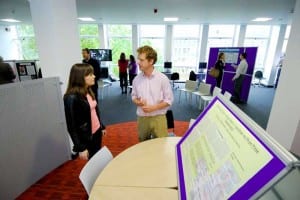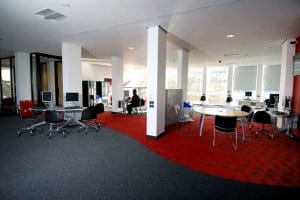Oxford Brookes University: The Reinvention Centre
Innovation
The focus for the case study at Oxford Brookes University is a space created for the Reinvention Centre for Undergraduate Research, a Centre for Excellence in Teaching and Learning. The Reinvention Centre for Undergraduate Research was developed by Oxford Brookes in partnership with the University of Warwick as part of a £3.3 million Higher Education Funding Council for England ( HEFCE) funded initiative, of which £600,000 was spent developing a new teaching and learning space at Oxford Brookes. This space takes its title from the HEFCE funded project and is known as the Reinvention Centre.
The aim of the Reinvention Centre for Undergraduate Research at Warwick and Oxford Brookes is to develop and support research-based learning across the undergraduate curriculum, and, in so doing, have an effect on the Higher Education sector as a whole, by encouraging other universities to regard research and research-like activities as part of the mainstream university provision for undergraduates.

A key feature of the Reinvention Centre for Undergraduate Research has been to consider the kinds of spaces that are required to facilitate research based-learning. The Reinvention Centre at Oxford Brookes was designed with this issue in mind:
‘…reinvention is about reinventing the undergraduate curriculum to have a mainstream focus on research and getting students involved in research- based learning… so it was a small leap to say that students need appropriate spaces, especially when these student research projects are often collaborative projects that work in ways that do not necessarily fit with a conventional library or classroom’ (Senior Academic).
The Reinvention Centre is four hundred square metres of teaching and learning space, with furniture that is designed to be rearranged into various configurations to fit the needs of particular student-led activities. The space cannot be booked for teaching activities during the timetabled working day, but can be used by academic staff for other events at other times. The space is designed to facilitate independent and autonomy among students, and is well supported with appropriate technology. The space is occupied by Reinvention Centre staff in adjacent offices so there is a strong sense of a shared purpose among the students and staff who use the space. The Reinvention Centre has a central location on the Gipsy Hill site with ease of access to the main campus library.
The space was designed as a less expansive version of Learning Grid at the University of Warwick, which has already established itself as a successful social learning space. The Reinvention Centre at Oxford Brookes shares many of the goals and aspirations of the Learning Grid, particularly the sense of student autonomy and independent learning, but there is a clear recognition by the staff that run the Centre at Oxford Brookes that the Reinvention Centre operates within the culture of its own particular institutional context.
Visions and Missions
Oxford Brookes is one of the leading post 1992 universities, with ambitions to be one of top fifty Higher Education Institutions in the UK. It wants to achieve this through having a strong reputation for both teaching and research. Oxford Brookes has already established a very strong reputation for innovative teaching through the work of the Oxford Centre for Staff Learning and Development. Despite its reputation for promoting innovation in teaching and learning Oxford Brookes does not impose any particular model for teaching on its own staff:
‘…[the university] has backed off from being too prescriptive…what we expect of schools are that they own their own student learning experience strategy…it is actually saying to colleagues that students learn more by teaching activities that are subject specific rather than attempting to provide a generic template for what constitutes good teaching and learning’ (Senior Academic).

Oxford Brookes has now developed a strong reputation for research in particular subject areas, that is recognized as being of international standard. However, Senior Managers are keen to emphasize that the university is still very much student-centred with teaching and learning as well as research activity an important aspect of being an academic at Oxford Brookes.
Oxford Brookes aims to ensure that the concept of student-centredness is a key principle that informs its thinking about the development of the university, including and, in particular, the university estate. The physical estate is seen as a key factor in terms of how the University will be able to realize its institutional aims and visions. Currently Oxford Brookes’ physical campus estate has an eclectic character possessing ‘…many characteristics of a new university, a 1992 generation university, but it’s also got many characteristics of an old university’ (Senior Manager). A particular issue for estate planners at Oxford Brookes is that while student-centredness is a key aspiration for the university, some students do not see the campus as being at the centre of their student life, and tend to leave the campus and study at home or in cafes in other parts of the city. One of the key issues for the university is to make the campus attractive enough for students to remain after their teaching activities are finished.
In the recent period Oxford Brookes has been developing a much clearer vision for its physical campus. There is a recognition that any such vision involves not only learning from what other universities have done, but of the necessity to take some risks in order to promote experimentation and innovation: ‘…to go for solutions which have already been tried out elsewhere while all the time be prepared to innovate, and maybe even to make a few mistakes, because if we don’t do that we’ll end up with something that is mediocre’ (Senior Manager).
Leadership and Governance
To achieve this vision, the University is going through a major process of campus master planning leading to refurbishment of the entire Gypsy Hill site. This process was facilitated by the Change Academy, ran by the HEA and the Leadership Foundation for Higher Education. The Change Academy provides support for teams from higher education institutions that enables them to develop the knowledge, capacity and enthusiasm for achieving complex institutional change. The Change Academy provides unique opportunities for team-based learning and professional development that focus on the strategic interests and needs of the participating institutions.

As part of this process Oxford Brookes have gone through a significant learning curve in terms of how it plans its physical campus: ‘When I came here there was an estates strategy, but it was literally written on one sheet of A4. I think it was safe to say that it wasn’t robust at all’ (Estates Manager). In order to further develop their campus master plan there has been an extensive process of consultation, involving staff from all parts of the university as well as students. The Students Union has played an active role in the process, with the President of the Union sitting on the University’s Programmes Steering Board. Interestingly, and unusually, this consultation with students has included contacting alumni for their views.
While the university has sought to use students as much as possible in the process of consultation about its new building programme there is also an acknowledgement about the limitations of the student voice on this matter:
‘The students are only here for a short time so their view is very much the current view. I think we need to be brave enough as professional people to say that we have a vision, we have the experience and the evidence to back it up. Students are a useful part of that evidence, but we’ve also got a view of what the experience is likely to be in the future’ (Senior Educational Developer).
The formal governance structures at the university are supported by processes which facilitate informal dialogue. One key aspect of this is that Oxford Brookes has a smaller committee structure compared to other universities, and a number of forums outside of the committee structures to discuss various aspects of university business. There is a very positive approach to the committee structure shown by some members of staff:
‘It’s about learning isn’t it? It’s about being open to change, open to development and that’s where I think committees can be really quite exciting places if you go with the view that you want to try and influence what happens next’ (Senior Educational Developer).
There is a good relationship between academic colleagues who are responsible for the development of the teaching and learning provision and the Estates department. Academic staff recognise they are now working in culture where:
‘The people in Estates know they’re not educationalists themselves and they’re prepared to listen and find out more about what education requires. We have had in the past a model where they didn’t; they thought they knew how to build buildings. Now these people really want to create buildings which are for education’ (Senior Educational Developer).
This view is shared by colleagues in the Estates department at Oxford Brookes who feel academics should provide leadership in terms of the development of the estate, by provoking change and innovation across the university.
Developing the Brief
What was significant about developing the brief for the Reinvention Centre space was that it was driven by a commitment to the notion of research- based learning, and that the space should facilitate this pedagogical approach. Although Warwick was the lead partner for the project much of the intellectual thinking and research on which the pedagogical approach was based was done at Oxford Brookes. This process was further enhanced by the fact that there was already a commitment in Oxford Brookes’ Teaching and Learning Strategy that the university should work towards a situation in which there was an increased amount of research-based learning in the undergraduate curriculum.

Another key aspect of the development of the brief was that it was designed across two universities, involving different subject disciplines with very different cultures: Sociology at Warwick and the School for the Built Environment at Oxford Brookes. While working across two different universities with different histories and cultures provided some moments of friction, the process is regarded by staff working across and between the two universities as having been a very productive one. What underpins this strong working relationship is the fact that, as managers of the project agree, the unifying principle that binds the project, connecting teaching and research at the undergraduate level, is both simple and persuasive.
As the Reinvention Centre space at Oxford Brookes was based on the Learning Grid at Warwick there were visits by Oxford Brookes’ staff to view the Warwick provision, as well as visits to similar types of learning spaces at other universities. There is a sense among those involved with the project that the architect may have slightly overcomplicated the design process in the initial stages, but once the designs were contained within the original formula based on the Warwick model the process ran more smoothly.
While there was general agreement between colleagues working across the two universities as to the physical design of the space, there has been a difference of emphasis about the nature and extent of the student management and responsibility for the space. At Warwick students are employed to run and manage the space with a high level of responsibility for delivering the support services for other students who are using the Learning Grid. Oxford Brookes is working towards a position where students have more control for the management of the Reinvention Centre space, but feel it is not yet ready to facilitate the level of student responsibility that is sustained at Warwick.
Project Management
Oxford Brookes have a very formal project management system with a very clear definition of the project benefits and project outcomes.
Post Project Evaluation
Oxford Brookes has a robust process of post-project evaluation, which includes an implementation review so that the university is clear about what has been delivered, set against what projects set out to do. An important part of the review process is that the university learns the positives from each project while not repeating the same mistakes, if any, on subsequent initiatives.
The Reinvention Centre at Oxford Brookes has been able to fund a PhD student who is looking at aspects of the built environment in Higher Education, with a focus on social learning spaces. The work of this student will prove to be an invaluable resource not only in terms of evaluation but also in terms of mainstream academic research.
Recent Comments